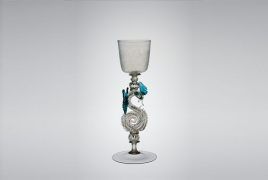Museum makes public centuries of secret glassmaking techniques February 11, 2016 - 16:55 AMT PanARMENIAN.Net - The Corning Museum of Glass has released its first-ever scholarly electronic resource, The Techniques of Renaissance Venetian Glassworking by artist and scholar, William Gudenrath, Art Daily reports. A culmination of a lifetime of research, this digital resource details the techniques used to make glass on Murano, Venice’s historic glassmaking island, between about 1500 and 1700, a period known as “the golden age of Venetian glass.” Through 360-degree photography and high-definition video, complete reconstructions of Venetian glassmaking techniques unknown for centuries are now revealed. It is a widely-held belief that Venetian techniques represent the pinnacle of difficulty in glassblowing. Studio glass artists have long studied Venetian glassblowing methods in an effort to develop and refine their skills, even if their work bears no relation to Venetian glass of any period. Not well known, however, is how Venetian objects of the Renaissance were made, as the Venetian government carefully kept secret the processes behind the technically-confounding glass coming out of Murano. “With the publication of this work, The Corning Museum of Glass has enabled lovers of Renaissance Venetian glass, whenever they reside or whatever their level of interest, to appreciate this material more deeply through the technical observations the work contains,” said Karol Wight, president and executive director of The Corning Museum of Glass. “Bill’s years of research and celebrated teaching methods come together in this electronic resource, an engaging and exciting way to further our mission to tell the world about glass.” Gudenrath is a glassblower, scholar, lecturer, teacher, and resident advisor at The Studio of The Corning Museum of Glass. He has devoted decades to the careful study of historical glassworking methods, with a strong emphasis on Venetian glass objects of the 16th-18th centuries, spending countless hours at his own glassblowing furnace attempting to recreate telling features noted in original objects. “This is my investigation into the probable working practices of some of the most skilled artisans of all time: the glassblowers of Renaissance Venice,” said Gudenrath, who presents more than 40 narrated demonstration videos in the electronic resource, illustrating the recreation of 25 “key objects” in The Corning Museum of Glass collection, as well as 10 additional techniques. “With no detailed contemporaneous descriptions of the maestros’ working methods, the objects alone must tell the story of how they were made.” Gudenrath has been teaching classes in Venetian glassmaking techniques to eager students at The Studio of The Corning Museum of Glass for years. This year—the 20th anniversary of The Studio he and his wife, Amy Schwartz, started in 1996—he’s excited to share this new resource with his students. “I envision this resource being a big help in teaching both the fundamentals and extremely advanced procedures to the many dedicated students of glassblowing in the Venetian style,” said Gudenrath. Gudenrath will present a lecture-video demo based on this electronic resource at this year’s Glass Art Society conference, which will be held June 9-11 in Corning. As part of an ongoing effort to make the collection more digitally accessible, The Corning Museum of Glass chose to release The Techniques of Renaissance Venetian Glassworking as a free, updatable electronic resource, full of rich content meant to inform the research of scholars, inspire artists, and captivate the curious public. “Scholars of glass reside around the world, as do the collections of Venetian glass,” said Scott Sayre, chief digital officer of The Corning Museum of Glass. “We want to make this knowledge available to the broadest possible audience by making it an easily accessed digital resource.” Photo: Art Daily The creative crew of the Public TV had chosen 13-year-old Malena as a participant of this year's contest. She called on others to also suspend their accounts over the companies’ failure to tackle hate speech. Penderecki was known for his film scores, including for William Friedkin’s “The Exorcist”, Stanley Kubrick’s “The Shining”. The festival made the news public on March 19, saying that “several options are considered in order to preserve its running” Partner news |